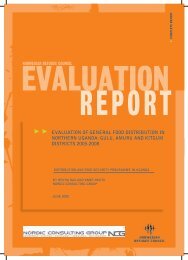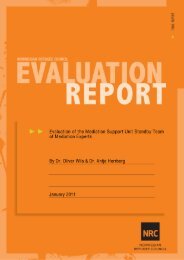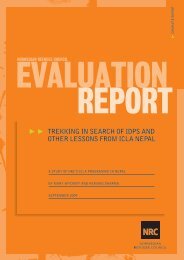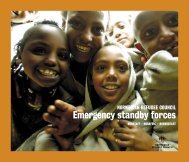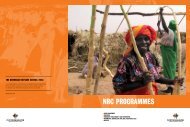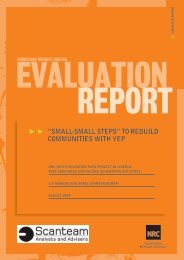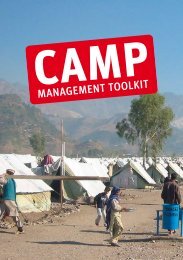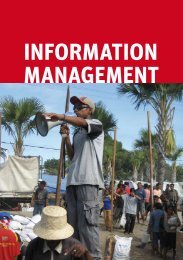Download report here - Norwegian Refugee Council
Download report here - Norwegian Refugee Council
Download report here - Norwegian Refugee Council
You also want an ePaper? Increase the reach of your titles
YUMPU automatically turns print PDFs into web optimized ePapers that Google loves.
Evaluation of NRC Food Security and Livelihoods Projects in Chiredzi and Chipinge Districts of Zimbabweother seed types provided (e.g. maize and sorghum rather than millet). In one community the planting ofsorgum seed was not allowed (taboo).6. Monitoring and EvaluationA number of sources raised significant concerns about monitoring structures and procedures for theprojects, including local government partners (Social Services and Agritex), NRC staff, beneficiaries,non-partner organisations working in the area, and past project monitoring <strong>report</strong>s / progress <strong>report</strong>s.Although Government stakeholders in Chiredzi seemed broadly satisfied with NRC interaction andcommunication, in Chipinge both Social Services and Agritex District staff complained of a lack of theirinvolvement in monitoring visits, and a desire was expressed for regular field visits (e.g. quarterly) toensure they are adequately updated on progress. It was indicated that although they were, for example,invited to goat distributions and similar events they had never been taken back to see progress.T<strong>here</strong> was significant evidence that failures of beneficiaries to fulfil their commitments, or even misusesof project resources by beneficiaries (e.g. deaths of livestock due to negligence such as not feeding ornot treating diseases) were not adequately followed up due to pressures on staff time. ActionAid inChiredzi also <strong>report</strong>ed NRC beneficiaries trying to sell “NRC pass-on goats” to an ActionAid goat project.The annual review of FSL projects noted that “beneficiaries are taking advantage of limited monitoringvisits by NRC”, and that livestock “deaths increased during periods when NRC staff were absent.Instances of misuse/consumption of animals were <strong>report</strong>ed. It is also possible that some <strong>report</strong>ed“deaths” may in fact have been unofficial sales. Progress <strong>report</strong>s in 2011 included <strong>report</strong>s of failure toundertake monitoring due to pressures on staff time, giving an impression that M&E was somethingundertaken if time permitted, rather than an essential activity. NRC has already begun to makecommendable progress on addressing M&E issues, including appointing an M&E Officer, and enablingtwo staff to undertake an M&E Course at the University of Zimbabwe. However the scale and diversityof NRC activities, and their geographical spread, mean that further reinforcement of M&E capacity isrequired. Potential solutions include :1. Increasing NRC’s in-house M& E capacity, e.g. by having separate M&E officers for the twodistricts, and an M&E coordinator, potentially based at HQ in Harare. ACF has a staff structureof this type for its Chiredzi operations, supplemented by data entry staff as required (ACFoperations are similar in scale to NRC, but less varied in project types or geographical spreadbeing limited to Low Veldt areas of Chiredzi).2. Strengthen monitoring partnerships with Government stakeholders like Agritex. At presentAgritex are supposed to support on monitoring but are not mobile (no transport), so they onlymonitor those who come to the Agritex offices. It was <strong>report</strong>ed that t<strong>here</strong> are some areas w<strong>here</strong>other NGOs support Agritex officers with motor bikes and fuel to enable them to undertakemonitoring of beneficiaries for most project activities. NRC Project Officers could then focus onverifying and directing the M&E activities. This could improve sustainability of Agritex support ofbeneficiaries after the end of the project, capacity build local structures, improve relationshipswith Government departments, and be a cost effective alternative to in-house staff.During 2011 monitoring was affected by the absence of any full time M&E staff, leading to a reliance onProject Officers and Agritex staff. Project officers were primarily focused on project implementation,limiting the time spent on M&E tasks, whilst and Agritex staff lacked mobility and thus failed toadequately monitoring. T<strong>here</strong> is a need to ensure that adequate budgetary provision for M&E activitiesis built into all project proposals, including provision for appropriate staffing resources.6. ManagementNRC is a newly established organization in Zimbabwe, having begun its Zimbabwe operations at thecommencement of the programs being reviewed <strong>here</strong>. Consequently t<strong>here</strong> was an initial lack ofestablished systems and procedures. Several of the problems identified below can be attributed to thenewness of the organization during 2011. Progress has since been made in addressing the sources ofthe problems, and the issues identified may t<strong>here</strong>fore to some extent be regarded as historic.28




